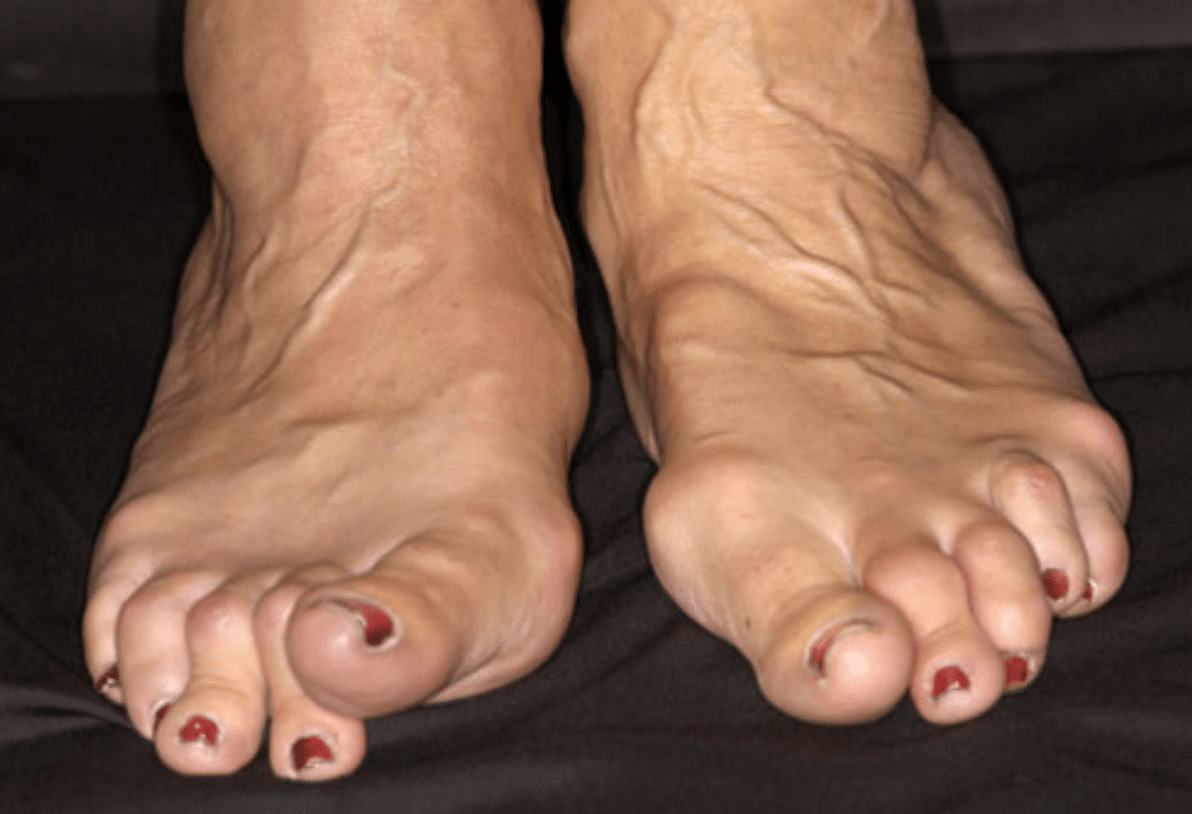Arthritis in the feet can have far-reaching effects on other parts of the body aside from the immediately affected joints. This is because your ligaments, tendons, and muscles are forced to work harder to maintain stability. This overuse can cause injuries to those ligaments, tendons, and muscles, including ankle sprains, torn ligaments and a greater likelihood of falls. Another significant concern for people over 75 suffering from is chronic pain, which has huge effects on your overall health as severe pain not only limits movement but also disturbs sleep and can lead to problems with overall well being and depression.
Osteoarthritis
Osteoarthritis is common in older people, as it is a direct result of wear and tear over time, particularly in the feet and knees as they are weight-bearing joints that have endured a huge amount of pressure over a prolonged period. Osteoarthritis is a general breaking down of the joint and usually causes pain and discomfort around the joint. You may also find that your range of movement is less than what it used to be, and your ability to walk could become affected.
Maintaining good foot health with Osteoarthritis
As with healthy, the key to maintaining good foot health if you have arthritis in the feet is a well fitting shoe. If you suffer from osteoarthritis, your feet can sometimes change structure, a shoe with adequate cushioning and support will help keep you walking.
During the fitting process for new shoes:
•Make sure there is enough space, ideally a minimum of 2cm between the end of the longest toe and the front of the shoe
•Ensure the heel counter is stable and supportive and that the shoe uppers are soft flexible to match the shape of the foot
•Ensure the ball of the foot matches the widest part of the shoe
•Do not purchase shoes that require breaking in
•The heel should fit comfortably and the shoes should not ride up and down on the heel when walking
•Buckles, laces or Velcro straps help keep the shoe on
Leather uppers and linings can reduce the likelihood of developing skin irritations, as can elasticised fabric uppers
Some special depth shoes can accommodate arthritic lumpy toes and prevent corns and calluses
Rheumatoid Arthritis
Rheumatoid arthritis is an autoimmune condition that causes the body to work against itself, breaking down joints and resulting in pain, swelling, stiffness and deformity around the joint. Rheumatoid arthritis usually presents itself earlier in life, but gets progressively worse over time, making the disease a serious problem for older patients. Again a range of movement can be severely affected, as can your ability to walk, as toes can become deformed and hammered, making walking extremely uncomfortable.
Maintaining Good Foot Health with Rheumatoid Arthritis
If your Rheumatoid arthritis affects your feet, a good shoe can help relieve pain and keep you mobile. The constant change in foot shape with this condition will require frequent reviews of your footwear
When Buying shoes look for:
•A stable supportive heel counter
•Space around the toes, with an extra depth leather toe box or stretch upper to accommodate any changes in the toes
•Lightweight and flexible material in the soles and uppers to help match the shape of the foot
•Few or minimal seams as these can become pressure or friction points
•Buckles, laces or velcro straps to hold the shoe onto your foot so your foot doesn’t have to do the work
Rheumatoid arthritis can be accompanied by arch collapse and a widening of the forefoot. Where the foot is badly splayed, or where joints have become swollen, the shoe must be able to accommodate a wider foot area.
During the shoe fitting process:
•Make sure there is enough space, ideally a minimum of 2cm between the end of your longest toe and the front of the shoe
•Ensure the ball of your foot matches the widest part of the shoe
•Do not purchase shoes that require breaking in
•The heel should fit comfortably and the shoes should not ride up and down on the heel when walking
Treatment
Treatments are available to alleviate and reduce the symptoms of arthritis. Your Podiatrist will carefully assess the severity of the condition and can recommend footwear, either off the shelf or custom made. To give problem joints more room, therefore reducing the risks of other injuries such as blisters, corns, and calluses that can be caused by shoes that rub on swollen areas. Orthotics can also be specially made to provide your feet with extra support and to give you more stability, making it easier to get around. There are also exercises you can do to help keep the joint moving, which will help relieve the stiffness and pain you may be experiencing. These treatments combined can greatly improve your quality of life and general comfort and mobility.
If you are concerned about your feet and lower leg health, contact us at Canberra Podiatry, please call us on 6281 1200.
es, the bodies defence mechanism basically gives up and there is a disconnection between the brain and the injured area.
At Canberra Podiatry we provide Extracorporeal shock wave therapy, and the beauty of this treatment is that it flips the switch back on and allows your body to heal itself naturally.
It increases the blood flow to the affected area which in turn aids in the healing process. If you suffer from long-standing pain (pardon the pun) due to these and other soft tissue tendon injuries then our experienced team can help. We’ve noted a close to 90% success rate after just 3 treatments, and there is no downtime during the process either.
Our experienced podiatrists have been looking after Canberra’s foot health since 1997 are here to both care for your feet and provide advice on how to keep them healthy between visits.
So call Canberra Podiatry today on 6281 1200 for an appointment.





